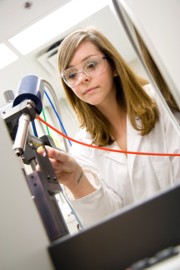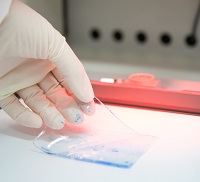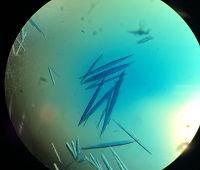


We are one of the six constituent core facilities of the London Regional Proteomics Centre, and are located in Room 333 of the Medical Sciences Building.
 We know that pure protein samples increase the likelihood of successful crystallization, and that the worst contaminants are those that are closely related to the target protein (i.e. degradation products). For this reason, we ask you to provide us with as pure a protein sample as possible, as judged by SDS-PAGE.
We know that pure protein samples increase the likelihood of successful crystallization, and that the worst contaminants are those that are closely related to the target protein (i.e. degradation products). For this reason, we ask you to provide us with as pure a protein sample as possible, as judged by SDS-PAGE.
Typical starting concentrations for crystallization trials are in the 10-15 mg/mL range, and sample volumes will depend on the number of screens you would like to set up. We request approximately 55uL of sample per 96-well screen, preferably in water or a low ionic strength buffer. Please avoid using phosphate buffer.
For more information about sample preparation, do not hesitate to contact us.
 Once you submit your sample, we can start our crystallization trials with one or all of our Qiagen 96-well crystallization screens, and these include:
Once you submit your sample, we can start our crystallization trials with one or all of our Qiagen 96-well crystallization screens, and these include:
Our 96-well plates have room for three samples per well, therefore we can screen from one to three different protein samples per plate (or 3 different concentrations of the same protein), allowing us to test from 96 to 288 conditions per trial.
Please be prepared to supply us with basic information regarding your sample. We would like to know:
A lot of this information can be obtained by simply entering your protein's name into the Expasy proteomics server or Expasy's ProtParam Tool.
What methods did you use to purify your protein? If you used a fusion-tag to ease in purification, did you remove it? If you are hoping to crystallize a complex of proteins, did you run it through a size-exlusion column first? These are things we need to think about (or discuss in-person, if you prefer) before we attempt to crystallize your sample.
Please provide us with a picture of your protein at its purest form, as judged by SDS-PAGE.
There are many different ways to learn about the stability of your protein, and to find out if your sample is monodisperse. You won't want to set up crystallization trials if your protein sample has degraded, aggregated or come out of solution over time.
Techniques such as gel filtration, dynamic light scattering and analytical centrifugation can be used to determine whether your protein sample contains aggregates, while simple analysis by SDS-PAGE, circular dichroism and differential scanning calorimetry can be used to check for degradation and thermal stability.